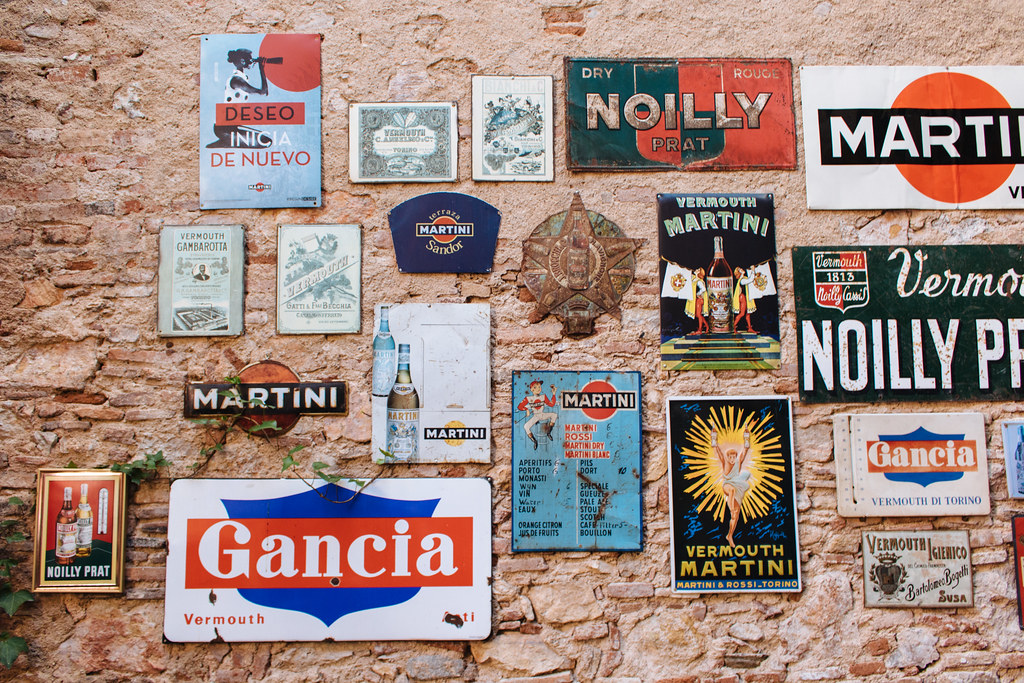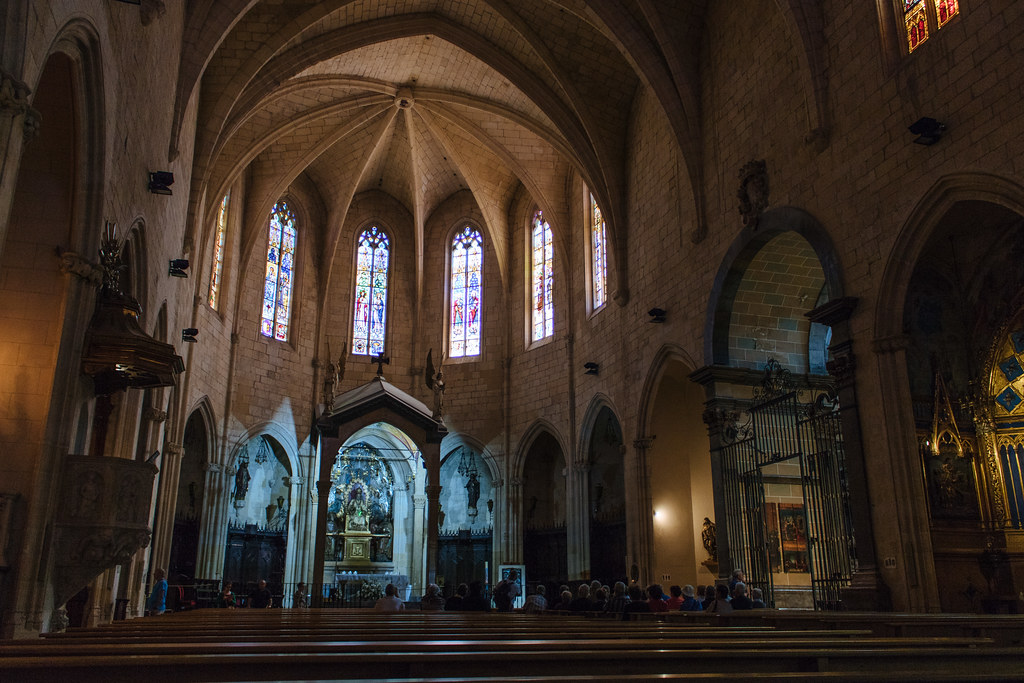Photo Post: Going Out for Vermouth in Reus, Spain
When people come to Spain for a visit they almost always try to get a glass (or three) of sangría, but to Spaniards this comes across as bizarre, as sangría is typically only consumed at parties, big family gatherings, or Sunday cookouts. It’d be like ordering spiked fruit punch at a sit-down restaurant in the States…just weird.
Instead of sangría, to get that iced-wine fix, Spaniards often order tinto de verano, which is simply a tall glass of red wine with lemon soda, ice, and maybe an orange or lemon slice. Fast and simple, refreshing but not inebriating, it’s a great choice for those hot summer months.
An authentic pre-dinner option is vermouth, a beverage that has seen an explosion in popularity in just the past few years as the younger generation has rediscovered this traditional Spanish drink. But what exactly is vermouth? Simply put: fortified, aromatized wine. Vermouth makers take a neutral spirit and macerate it with selections of up to 70 different herbs, spices, and roots that lend a medicinal quality to the drink. After letting these botanicals work their magic, manufacturers add white wine (not red), caramel (for coloring), and sugar to finish the product.
Vermouth has been around for over a hundred years in Spain, first introduced from France and Italy via the small northeastern town of Reus (pronounced “RAY-oos” [rɛws]). In that time, Spaniards—especially the Catalans—developed a fun, simple tradition around imbibing vermouth called “fer el vermut.” Literally “doing vermouth,” this custom involves going out to the bar down the street from your house with friends and family to order a glass or two of vermouth before midday dinner while nibbling on salty snacks like olives, potato chips, and gourmet tinned seafood (like mussels). Once you’ve worked up an appetite with this apéritif, it’s time to go back upstairs and have dinner.
Although Spaniards across the country are fond of a good glass of afternoon vermouth, there’s no better place to engage in this tradition than Reus, where no fewer than five vermouth makers operate today, including famous brands like Yzaguirre and Miró. Rofes, a more locally-known but still quality brand, operates a restaurant-bar combo out of its historic factory that dates back to 1890 on Carrer de Sant Miquel, Nº 4. Sip on a cold glass of sweet vermouth with an orange slice at the stainless-steel bar while you try to parse the Catalan-language newspaper and you’ll feel super Catalan.
If you’re as much a vermouth aficionado as I am, you’ll love exploring the free Vermouth Museum, whose walls are bedecked in posters, certificates, dusty bottles, and trinkets from decades ago. This two-story complex is really a restaurant and bar that happens to have vermouth-related memorabilia throughout the dining rooms, but it’s nice because you can stroll through and check out the glamorous turn-of-the-century art and then grab a glass of vermouth, some olives, and maybe some canned clams or vinegar-cured anchovies to round out your visit. Check out the Museu del Vermut at Carrer de Vallroquetes, Nº 7.
The town of Reus draws pilgrims not only for being the birthplace of Spanish vermouth but also for being the hometown of famous Art Nouveau architect Antoni Gaudí. Yes, that Gaudí. You can walk down a quiet residential street and find the nondescript house he grew up in (it’s in private hands today, so don’t make a scene), and you can enter the Priory Church of Sant Pere, the church he was baptized and confirmed in. Sadly, nobody in Reus ever commissioned their local son to design any houses or mansions, but the town nevertheless has a fine collection of whimsical, pretty Modernista-style buildings.
The Spanish national railway operator Renfe runs trains about once an hour to Reus from Barcelona’s França, Passeig de Gràcia, and Sants train stations. These trains take about an hour and 45 minutes to arrive, stopping in some villages as well as the provincial capital of Tarragona along the way.
Instead of sangría, to get that iced-wine fix, Spaniards often order tinto de verano, which is simply a tall glass of red wine with lemon soda, ice, and maybe an orange or lemon slice. Fast and simple, refreshing but not inebriating, it’s a great choice for those hot summer months.
 |
| Miró vermouth at the Museu del Vermut |
An authentic pre-dinner option is vermouth, a beverage that has seen an explosion in popularity in just the past few years as the younger generation has rediscovered this traditional Spanish drink. But what exactly is vermouth? Simply put: fortified, aromatized wine. Vermouth makers take a neutral spirit and macerate it with selections of up to 70 different herbs, spices, and roots that lend a medicinal quality to the drink. After letting these botanicals work their magic, manufacturers add white wine (not red), caramel (for coloring), and sugar to finish the product.
 |
| Rofes vermouth + snacks |
Vermouth has been around for over a hundred years in Spain, first introduced from France and Italy via the small northeastern town of Reus (pronounced “RAY-oos” [rɛws]). In that time, Spaniards—especially the Catalans—developed a fun, simple tradition around imbibing vermouth called “fer el vermut.” Literally “doing vermouth,” this custom involves going out to the bar down the street from your house with friends and family to order a glass or two of vermouth before midday dinner while nibbling on salty snacks like olives, potato chips, and gourmet tinned seafood (like mussels). Once you’ve worked up an appetite with this apéritif, it’s time to go back upstairs and have dinner.
 |
| Memorabilia at the Museu del Vermut |
Although Spaniards across the country are fond of a good glass of afternoon vermouth, there’s no better place to engage in this tradition than Reus, where no fewer than five vermouth makers operate today, including famous brands like Yzaguirre and Miró. Rofes, a more locally-known but still quality brand, operates a restaurant-bar combo out of its historic factory that dates back to 1890 on Carrer de Sant Miquel, Nº 4. Sip on a cold glass of sweet vermouth with an orange slice at the stainless-steel bar while you try to parse the Catalan-language newspaper and you’ll feel super Catalan.
If you’re as much a vermouth aficionado as I am, you’ll love exploring the free Vermouth Museum, whose walls are bedecked in posters, certificates, dusty bottles, and trinkets from decades ago. This two-story complex is really a restaurant and bar that happens to have vermouth-related memorabilia throughout the dining rooms, but it’s nice because you can stroll through and check out the glamorous turn-of-the-century art and then grab a glass of vermouth, some olives, and maybe some canned clams or vinegar-cured anchovies to round out your visit. Check out the Museu del Vermut at Carrer de Vallroquetes, Nº 7.
 |
| Birthplace of Antoni Gaudí |
The town of Reus draws pilgrims not only for being the birthplace of Spanish vermouth but also for being the hometown of famous Art Nouveau architect Antoni Gaudí. Yes, that Gaudí. You can walk down a quiet residential street and find the nondescript house he grew up in (it’s in private hands today, so don’t make a scene), and you can enter the Priory Church of Sant Pere, the church he was baptized and confirmed in. Sadly, nobody in Reus ever commissioned their local son to design any houses or mansions, but the town nevertheless has a fine collection of whimsical, pretty Modernista-style buildings.
How to get there
 |
| Priory Church of Sant Pere |
The Spanish national railway operator Renfe runs trains about once an hour to Reus from Barcelona’s França, Passeig de Gràcia, and Sants train stations. These trains take about an hour and 45 minutes to arrive, stopping in some villages as well as the provincial capital of Tarragona along the way.